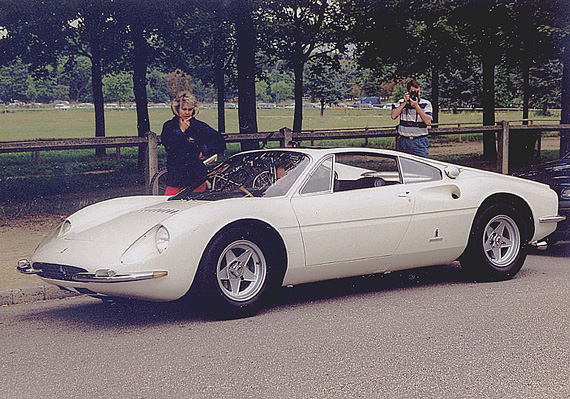
Gooding & Company announced this week that the Chinetti 365 P Tre Posti had been consigned for their Pebble Beach sale. This is an incredible confluence of design, performance and provenance. It will certainly be near the top of the charts during the Monterey auctions in August. Photo by Hugues Vanhoolandt.
By Michael T. Lynch
In our last piece (Is the End Nigh?) we mentioned a yet-to-be-announced Ferrari that would be one of the highlights of the auctions during the Monterey Bay auto week. Last week, Gooding and Company confirmed that they will have the Ferrari 365 P Berlinetta Speciale “Tre Posti” in their Pebble Beach sale.
The Tre Posti s/n 8971 is an outstanding example of not just Italian coach-building and engineering excellence, but represents an era when Italy was a style leader in many design disciplines. The Tre Posti is an artifact that takes its place as a symbol of mid-century Italian design on a par with Olivetti’s Lettera 22 and Pier Luigi Nervi’s Exhibition Hall in Turin. The nickname comes from the car’s three abreast seating with the steering wheel in the middle, a feature that preceded the McLaren F1 by a quarter century.
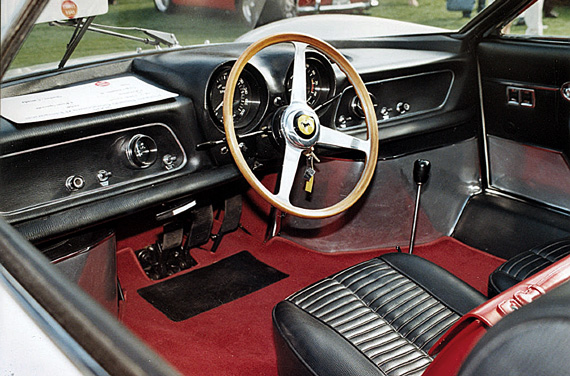
The center-steer cockpit is a combination of luxury and competition references. The latter include the gated shifter, the P2 pedal box and the untrimmed lower panels. Photo by Hugues Vanhoolandt.
Provenance contributes greatly to the value of a collector car and the Tre Posti’s includes three of the most important people in the history of sporting automobiles. It was designed by the famous coachbuilder, Pininfarina. It was built on a racing chassis created at Enzo Ferrari’s factory where the greatest sports and racing cars of the era were produced. Finally, it was specially modified for and imported by the man who built the Ferrari marque in both Europe and the U.S., Luigi Chinetti, Sr. He won Ferrari’s first Le Mans 24 Hours in 1949 and was the entrant for the marque’s last win there in 1965.
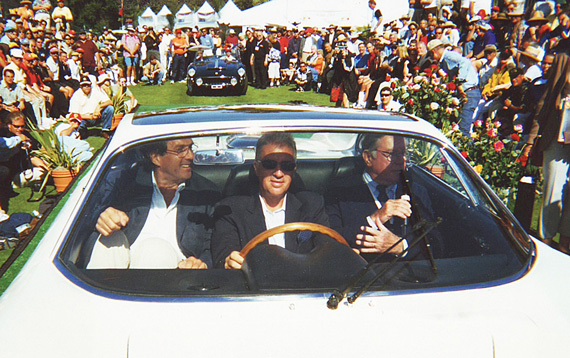
In 2001, Concorso Italiano had an impressive display of Pininfarina concept cars of which the Tre Posti was one. Three accomplished sons of three famous automotive personalities drove it across the ramp. Luigi Chinetti, Jr. (l) enjoys the ride, Piero Ferrari drives and Sergio Pininfarina talks to the crowd on the microphone. Credit: Concorso Italiano.
Ferrari once said that rear-engine cars “…put the cart before the horse.” That sentiment kept Ferrari behind the curve with his racing efforts when rear-engine cars began winning Grand Prix races in 1958. Ferrari finally reacted in 1960 with a 1.5 liter V-6 rear-engine Formula 2 car that was among the fastest in its class. The same concept was applied to both Ferrari’s Grand Prix and sports racing cars in 1961 with the 156 and 246 models. That year, the 156 “Sharknose” won both the Drivers (Phil Hill) and Manufacturers Grand Prix Championships. The season included a remarkable 1-2-3-4 finish at the Belgian Grand Prix. Success continued in the 1961-62 Sports Car Manufacturers Championship, with both front-engine V-12s and rear-engine V-6s.
In 1963, Ferrari introduced the 250 P, a sports racer that was his first V-12, rear-engine car. Variants of up to 4.4 liters would dominate the sports car championship for two of the next three seasons. In 1966, the combination of Ford and Goodyear money allowed the former to take the Manufacturers Cup, but Ferrari regained the title in 1967.
It was against this backdrop that Batista Pininfarina and his son, Sergio had tried to convince Ferrari to build a road-going rear-engine car. However Ferrari was not interested, feeling a traditional Ferrari V-12 behind the driver would be too demanding for the casual Ferrari customer.
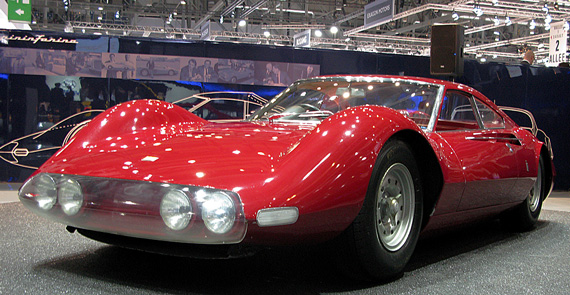
The 1965 Dino prototype. It is seen at a Pininfarina design exhibition at last year’s Geneva show. The years have not been kind to the Plexiglas covering over the front lighting system.
To further their case, Pininfarina created a prototype V-6 rear-engine concept that was introduced at the Paris Salon in October, 1965. It was a street version of the 206 S race car built on 206 S chassis s/n 0840. The car had styling cues that would resonate with future Ferraris for some time – the rear flank air intakes with strakes, the flying buttress rear window treatment and the exaggerated high front fender line with the sloping front deck were examples. The full width Perspex screen for the lighting would inspire the Daytona. With its impossibly low roofline and poor integration of the front and rear of the car, it was not an entirely successful design, but it was influential and launched other concepts that led to the production 246 Dino.
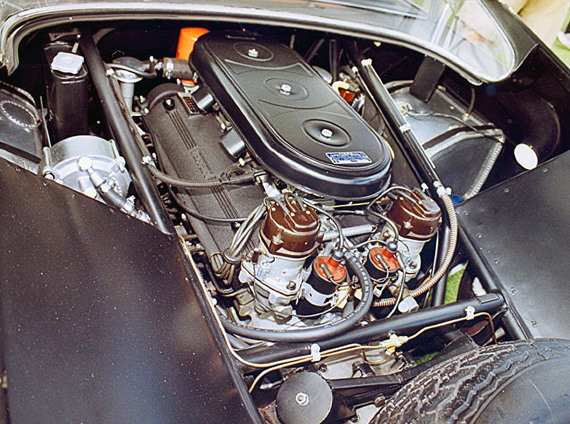
The 5 liter engine has separate coils and distributors for each cylinder bank. Note the traditional Ferrari riveted tank at the right. Photo by Hugues Vanhoolandt.
At this point Ferrari was contemplating a rear-engine design as long as it had the limited power of the small V-6. However, Pininfarina had visions of a PF-bodied supercar and secured a lengthened version (2200mm to 2400) of a 365 P2 chassis. The 365 P2 was a sports racer built for private teams like Chinetti’s NART. It was almost identical to the 330 P2 works cars except that the factory cars used a 4-liter engine with dohc, while the 365 P2s had the less complicated 4.4-liter sohc engine. Chinetti’s 365 P2 won the 12 Hours of Reims in 1965 with Pedro Rodriguez and Jean Guichet.
Pininfarina took the race-oriented chassis and showed what a modern supercar could be. He would make the first rear-engine Ferrari V-12 road car. Sergio never liked to credit any one design to an individual, but on this car he wanted to make a statement about his firm’s prowess and worked closely with his Chief Designer, Aldo Broverone. In the process, he created one of the great Ferraris of all time.
The body reflects some of the 1965 Dino concept cues, but there is no mistaking this 380 horsepower bolide for a Dino. It is more like a luxury Grand Prix car for the road and its central seating allows you equidistant views of the front fenders just like a Grand Prix driver looking at his open wheels.
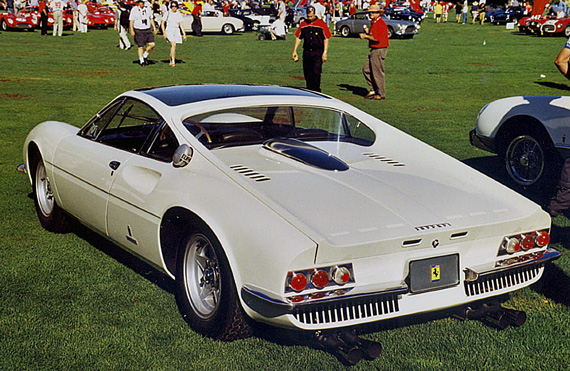
The rear ¾ view shows the car off to its best advantage. The curved rear light and the swoop from the roofline that doesn’t resolve itself until the very end of the rear deck are a classic example of an invocation of speed while standing still. Contrasting that flow are the rear deck louvers and the vertical vents on the rear valance. At the very bottom are the oversize exhaust pipes which suggest the power of the car. Photo by Hugues Vanhoolandt.
The side intakes are more pronounced, and the rear window is similarly tunneled. The competition heritage is invoked by an outside racing fuel filler. Some of the details harkened back to Vignale bodies where the smaller items were jewel-like. One was the polished metal air intake on the rear deck. Besides the central seating, another feature that was very advanced and expensive for the time is the athermic transparent roof.
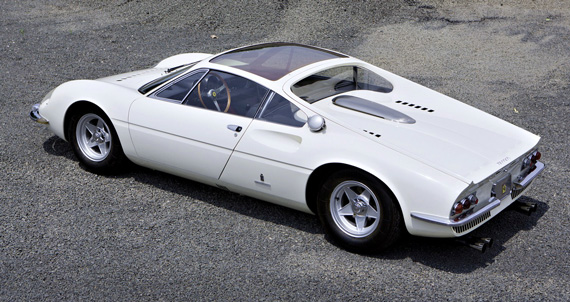
This view shows the polished air intake, the specially cast wheels, the outside fuel filler and the transparent roof. Credit: Gooding and Company
The five-spoke wheels are a theme in many following Ferraris. Unlike many show cars that were rushed to make a date, the Tre Posti is a completely finished road car. The interior, with special instrumentation, switches and hand-formed controls is that of a Grand Routier. The Gardenia White paint brings attention to the darker moonroof.
With the Tre Posti, Pininfarina had created a masterpiece and wanted to be sure the press and public saw it. In the fall of 1966, it was on the Pininfarina stand at the Paris Salon and the Earls Court Motor Show. The following year it was shown at Brussels and Geneva and it was entered at the Florence Concours in May.
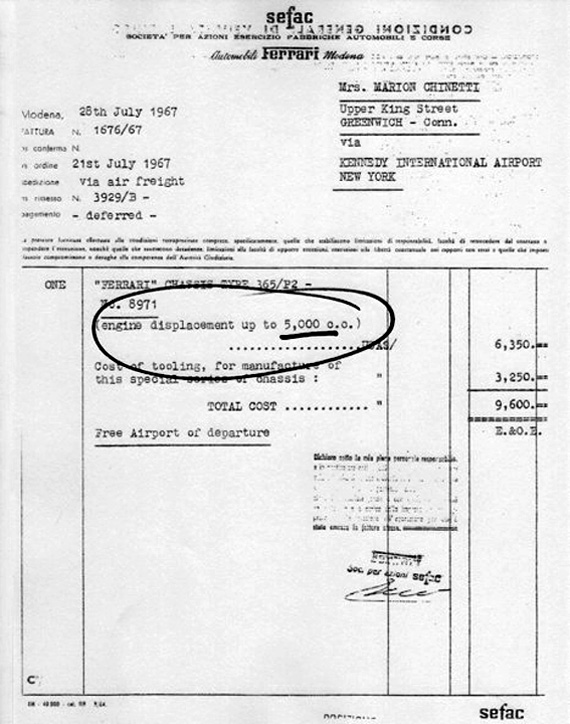
This is Ferrari’s invoice to Chinetti for the bare chassis and the upgrade to the engine. There was a further invoice from Pininfarina for $11,560, making a total of $21,160. Other documents show that Carton was credited $8,000 for his 500 Superfast and the Tre Posti’s delivered price was $26,000, the most expensive car the Chinettis had sold to that point. Credit: Chinetti Family Archive
Meanwhile, as Luigi Chinetti awaited the car’s delivery to the States, he put his own stamp on it. From the late 1940s, Chinetti had pushed Ferrari to make larger engine cars, explaining that the 2.0 and 2.6 liter cars Ferrari was delivering to the U.S. had a hard time matching the pace of the Cadillac and Chrysler-engined Allards and American specials with displacements of well over five liters. Chinetti wanted to be sure the Tre Posti was the fastest car on the road, and had Ferrari take the engine out from 4.4 to 5.0 liters. Some claim this displacement cannot be achieved with the Type 209 block, but the attached invoice from Ferrari to Chinetti would seem to indicate otherwise.
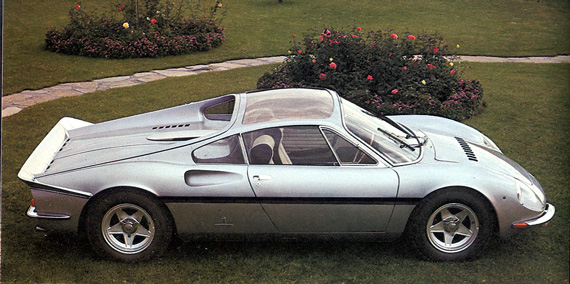
The Agnelli version of the Tre Posti is not as elegant as the Chinetti car. The painted beltline and overwhelming spoiler break the spell of the flowing lines. Credit: Pininfarina
Another automotive personality was also taken with the Tre Posti – Gianni Agnelli, the head of FIAT. He had Pininfarina make another one – s/n 8815 but with some modifications. They included a large lateral spoiler which conflicts with the complex lines of the flying buttress rear window and deck treatment and elegant Kamm rear end. There is little doubt that the Chinetti car is the more successful design.
The Tre Posti came to the U.S. in 1966 after its tour of the world’s great auto shows, having been presold to Marvyn Carton, the Executive Vice President of investment bank Allen & Company, a firm known for its privacy. Carton traded in a Ferrari 500 Superfast.
Chinetti sent the car to the Los Angeles Imported Automobile and Sports Car Show in October 1967 and it was delivered to Carton when it returned from the West Coast. The car proved to be more than Carton had bargained for, and it was traded back to Chinetti that year for a 365 2+2, a car more appropriate for driving in New York City.
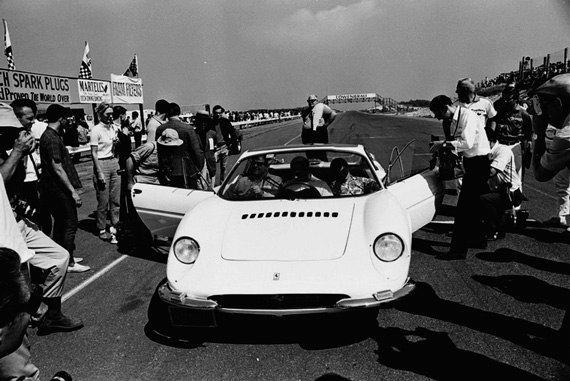
Two unknown VIPs are about to be driven around Bridgehampton by Stirling Moss in the Tre Posti during the 1968 Can Am weekend. Moss did promotional work for Johnson Wax, the series sponsor. Moss arrived for the weekend in an Intermeccanica Italia. Bridgehampton was the Chinettis’ home track, and their driver, Pedro Rodriguez took a 3 liter 250 P to a 5th place finish against Can Am cars with twice the displacement. Credit Johnson Wax.
In mid-1968, the car was sold to one of the most colorful Ferrari characters of the era, Dutchman Jan de Vroom, who traded a 275 GTB/4. De Vroom was a Chinetti customer and backer of the Chinetti’s North American Racing Team. He owned some great Pininfarina designs including the striking 410 Superamerica s/n 0719. He also raced Ferraris. He was a regular on the New York society scene, often accompanying Margaret Rockefeller Strong, who was married to George Cuevas, the founder of the Ballet Russe, later the Le Grand Ballet du Marquis de Cuevas. Cuevas was a true impresario and had Nijinsky as a choreographer and introduced Nureyev to Western audiences. De Vroom’s relationship with Margaret is unclear, but she did buy him a house in Palm Beach. After enjoying the car in the South of France as a guest at the Cuevas’ Villa San Lorenzo in Cannes and having the car serviced at the factory, De Vroom traded it back to the Chinettis in 1969 where it has remained for 44 years.
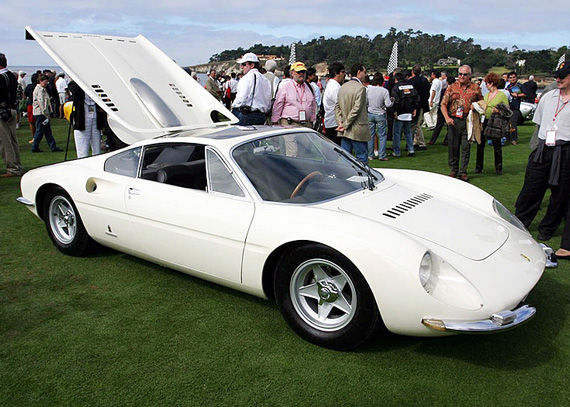
Over the years, Luigi Chinetti, Jr. has shared the Tre Posti with enthusiasts around the world. The car has been to Goodwood, Concorso Italiano, Meadowbrook, the Louis Vuitton (New York and Paris), and the Ferrari Festival at Brands Hatch. It is seen here at Pebble Beach as the dreaded morning fog is just beginning to break up.
This Ferrari, the fruit of the collaboration of Enzo Ferrari, Sergio Pininfarina and Luigi Chinetti, will be sold at the Gooding and Company Pebble Beach sale during the Pebble Beach Concours d’Elegance. If you want a nice, original condition vintage Ferrari icon with less than 5,000 miles, here’s your chance. If you happened to submit the winning bid, remember the Brockbank cartoon – don’t take your wife and mistress for a ride at the same time.
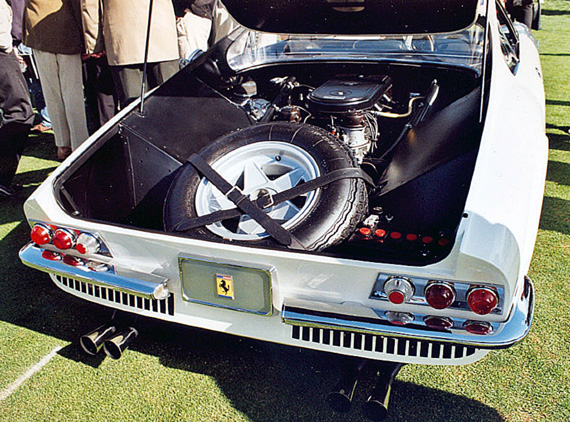
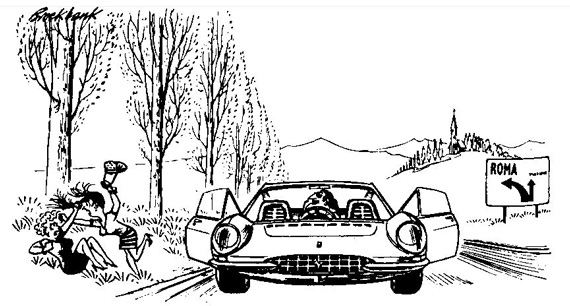
Amazing Ferrari which I remember seeing not long after Carton acquired it, blasting across town heading East on 57th Street from Fifth Avenue. Was standing on Tiffany & Co’s corner and heard that unforgettable and mighty roar. It was a priceless Ferrari- Chinetti-Pininfarina moment. Later I saw this landmark many times while a neighbor to Luigi Chinetti, Jr. in Connecticut and more recently while on
loan to the Simeone Museum.
Larry Wilson
Michael, I distinctly remember seeing this stunning car at the San Francisco International Auto Show at Brooks Hall when I was a young boy. Could it have been on its West Coast swing in 1966? For me, it remains the absolute pinnacle of Italian style and luxury. I can still see the iridescent white paint, glittering brightwork, and the way the cockpit seemed to glow under all that glass in the spotlights. If only Quantatative Easing had blown up my net worth a little more (well, maybe A LOT more)…
Strange that you say the Tre Posti was with Chinetti from 1969 until now, as I believe I saw this same car inside, and backed up against a garage wall at a Texas Ferrari dealership – probably in the late 1980’s to early ’90’s.. I know I saw a 3 seat Ferrari coupe. as I questioned the salesman about it. He seemed to shrug it off as a real oddball. It was likely in Houston. I may even have a pic of it somewhere as I was big on taking pics of anything exotic that I ran across.
I only took a quick look at it as I was more interested in either a Dino or Fiat Dino – as I remember. At the time, I was driving a ’72 Pantera. (bottomless money pit……..)
Joe
north of Orlando
Michael, lets not forget the Luigi also showed 8971 at Cavallino several years ago. This is definitely a very very special car and it will be interesting to see how well it does at auction. The owner if this Ferrari will have an very special car.
Absolutely captivating article, Michael, in the style and attention to detail so appreciated by us Ferraristas….well done!
Thanks to Michael for digging all this up, especially with the high quality pictures. It looks to me like Coco is sitting on a huge mountain of Ferrari treasure if you could his old race cars. but establishing a value of the 3-seater is difficult if it has never been sold (can we could Marvyn’s buy if he returned it?). Maybe we could at least trace the other three seater, the one that Bud Keeney sold in 1975–does anyone know what he sold it for to Mecom–but then again a 1975 value-as-shown-by-price is not much help in 2014. I would like to guess the white car will go for $10 million but then isn’t it a chassis with ho racing history? It’s not like the 375LM that young Chinetti and Bob Peak had fitted with a custom body–that was a real race car with LeMans provenance behind it and has no been rebodied as a race car again. I think Gooding’s estimate of $20 million is a stretch but, hey, this is one you could drive down Sunset strip…
The tre posti is a fabulous collaboration of legendary people including the founder
of the company.A small note;The Matra had a production three seater around the same time.
Pinin Farinas’ use of the flying buttress dates from at least the mid fifties, being used on at least one Lancia Aurelia PF200 Coupe, on their Fiat 8V Coupe, and also subtly on the Lancia Florida/Flaminia.
I saw the silver car at the first Monterey Historics in 1974… unattended in the parking lot! I may still have grainy 110 photos of it somewhere.
I think you might be wrong on the sale of #8971 in 1975 as in 1976 I was selling my 330 GTC #10401 to buy a sailboat. Bud Kenny saw my ad and called me asking about the car then said he had the 355P2 which I new from reading Automobile Year. Then he said “Hey,, I’ve got a one mile track in my industrial park in Irvine and you really owe it to yourself to come down and drive this,, Sam Posey drove it and said its better than a Daytona” . I think he wanted 30k for it then.
I think Dr Simeone owns this car. At least I saw it on display in his museum in Philly four or five years ago.
Simeone Auto Museum in Philadelphia, Pa – USA
http://www.e90post.com/forums/showthread.php?t=819882
^^scroll down half way thru my photos for the white 365P…
Dackel
To substantiate what Joe Dunlop said about seeing the car at a dealership in Houston , I can add that I did see this or a similar car at Forristal’s in Houston during the time frame he mentioned. It was a center steering wheel three seat, Pininfarina designed, covered headlight Ferrari. Curiously, I may have purchased the Dino he mentioned looking at there, and oddly I remember the salesman acting a little indifferent to the car, almost as if it wasn’t worth really considering as a purchase.
i think it did a few demo laps at that monterey historics too
Yep, it was at Forristal’s in Houston. My brother was dying of cancer in that area and I was not going to miss a stop at Forristal’s. Yes, the car was solid white. I’ll see if I have some pics from that trip, but I can’t remember taking any of this car – although it was definitely the same car. I believe I asked the salesman what they wanted for it and he mumbled something dismissive. Kinda reminds me of the burgungy/tan 275GTS I was taken for a ride in and offered for about $45K in the early ’90’s from a small foreign car shop in Winter Park, Fl. (suburb of Orlando). Some (bad) memories are best banned from ones memory banks………